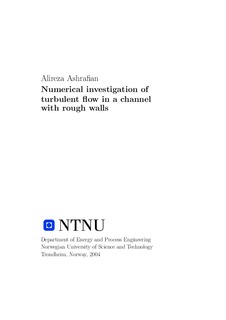Numerical Investigation of turbulent Flow in a Channel with rough Walls
Doctoral thesis
Permanent lenke
http://hdl.handle.net/11250/231266Utgivelsesdato
2004Metadata
Vis full innførselSamlinger
Sammendrag
Direct numerical simulation has been performed in order to study ressure-driven turbulent flow in a rod-roughened channel at Reynolds number Reτ = 400 (based on the mean pressure gradient). Square rods were attached to both channel walls and protruded only 0.034 of the channel’s half-height into the flow. Roughness elements were spaced at 7 heights, which corresponded to the so-called “k–type” laboratory roughness.
The classical logarithmic variation of the mean velocity was found to be maintained in the rough-wall channel flow. The only effect roughness had was to shift the log-profile downwards, the magnitude of which was about 7.1. This, corresponded to the upper limit of the transitionally rough region, based on the associated equivalent sand-grain roughness height. Within the layer of thickness about 3-5 times roughness height (roughness sublayer ), the dependency of the mean velocity and turbulence properties on the streamwise location with respect to the rods was revealed.
Instead of viscous sublayer, an intensive shear layer was formed emanated from the crest of roughness elements. It was observed that the wall-ward transport of the kinetic energy was substantially increased very close to the wall while the transport of the kinetic energy away from the wall was relatively reduced at just about the edge of the roughness sublayer. Visualizations of the fluctuating velocities and vortices in this region revealed the presence of elongated streaky structures very similar to those routinely observed in the structure of the smooth-wall turbulence, with much shorter coherence in the streamwise direction and less organization in the spanwise direction. The intensity of the vorticity fluctuations in the roughness sublayer were increased whereas in the outer layer, they remained unaffected. The anisotropy invariant maps for the smooth and rough cases clearly showed that the state of the near-wall turbulence for the two cases were substantially different, whereas in the regions away from the wall, the two cases exhibited similarities. Generally, the results obtained from this study supported the classical wall similarity hypothesis.
Består av
Ashrafian, A; Andersson, HI; Manhart, M. DNS of turbulent flow in a rod-roughened channel. International Journal of Heat and Fluid Flow. 25(3): 373-383, 2004.Ashrafian, A; Bakken, OM; Krogstad, P-Å; Andersson, HI. Rough-wall turbulence - a comparative study. Advances in Turbulence - Proceedings of the 10th European Turbulence Conference: 293-296, 2004.
